The Radeon R9 280X Review: Feat. Asus & XFX - Meet The Radeon 200 Series
by Ryan Smith on October 8, 2013 12:01 AM ESTPower, Temperature, & Noise
As always, last but not least is our look at power, temperature, and noise. Next to price and performance of course, these are some of the most important aspects of a GPU, due in large part to the impact of noise. All things considered, a loud card is undesirable unless there’s a sufficiently good reason – or sufficiently good performance – to ignore the noise.
With the Tahiti based 7970GE, we saw AMD push some very high voltages when boosting in order to hit their 1050MHz clockspeed targets. With 280X on the other hand they can back off at least a bit, which should help real world power consumption some.
| Radeon HD 7970/200 Series Voltages | ||||||
| Asus 280X Boost Voltage | XFX 280X Boost Voltage | Ref 7970GE Base Voltage | Ref 7970GE Boost Voltage | Ref 7970 Base Voltage | ||
| 1.2v | 1.2v | 1.162v | 1.218 | 1.175v | ||
On both our stock and factory overclocked 280X cads we see a boost voltage of 1.2v, which as expected is a bit lower than the 1.218v the 7970GE drew under the same conditions.
We also have a quick look at clockspeeds while gaming, although there’s little to report here. Without the ability to see the intermediate clockspeeds on 280X we can only tell whether it’s boosting or not. In every game on both 280X cards, these cards are always in a boost state.
| Radeon R9 280X Average Clockspeeds (Reported) | ||||
| Asus 280X | XFX 280X | |||
| Boost Clock | 1070MHz | 1000MHz | ||
| Metro: LL |
1070MHz
|
1000MHz
|
||
| CoH2 |
1070MHz
|
1000MHz
|
||
| Bioshock |
1070MHz
|
1000MHz
|
||
| Battlefield 3 |
1070MHz
|
1000MHz
|
||
| Crysis 3 |
1070MHz
|
1000MHz
|
||
| Crysis: Warhead |
1070MHz
|
1000MHz
|
||
| TW: Rome 2 |
1070MHz
|
1000MHz
|
||
| Hitman |
1070MHz
|
1000MHz
|
||
| GRID 2 |
1070MHz
|
1000MHz
|
||
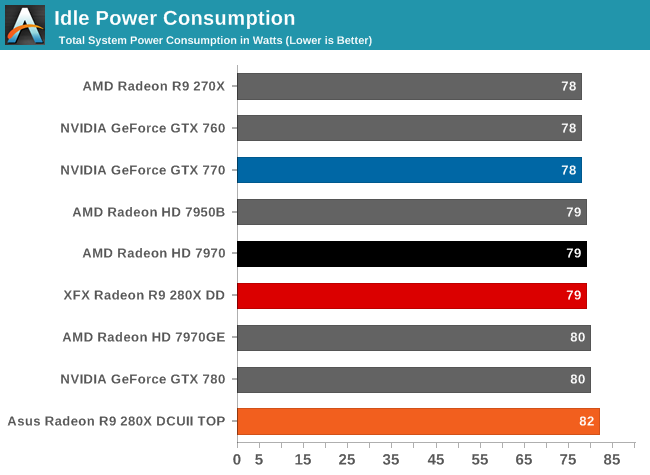
One of the advantages of our new testbed is that IVB-E and the testbed as a whole draw a lot less power under load and idle. This makes it easier to isolate video card power consumption from the rest of the system, giving us more meaningful results.
In this case though there are no surprises to be found with idle power consumption given just how similar all of these cards are while idling.
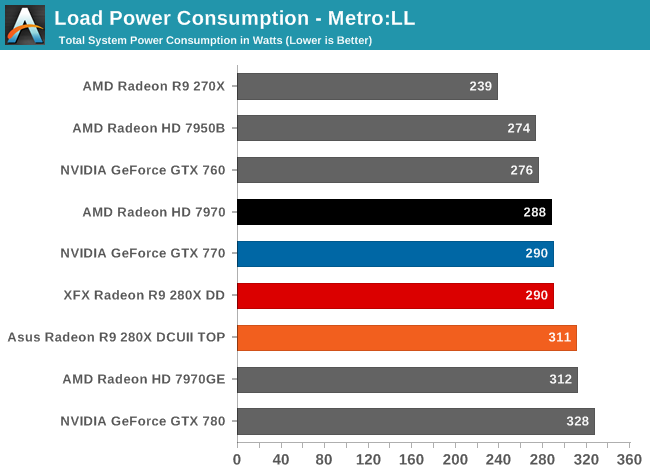
Up next is our new gaming power load test, for which we’re using Metro: Last Light. This was initially calibrated against a GTX 780, in which we found that Metro is both highly repeatable, runs long enough (when looped) to fully exercise a video card, and the load it puts on video cards as a percentage of allowable TDP is considerably average among all games.
To that end Metro paints an interesting picture of power consumption for the 280X. Despite its identical to the 7970GE TDP of 250W, real power consumption is down versus that card, and at least at the wall is identical to the 230W GTX 770 (not that NVIDIA and AMD measure TDP in the same way). What this tells us is that alongside their similar on average performance, the GTX 770 and 280X also draw similar amounts of power under gaming workloads.
Meanwhile Asus’s 280X draws more power, closer to a 7970GE, but this is not unexpected for a factory overclock.
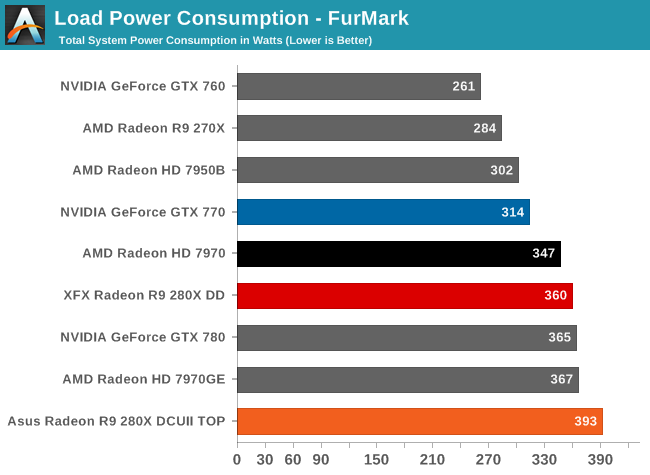
FurMark on the other hand, being the TDP buster that it is, paints a different picture of the situation. The 280X can generate and sustain a much higher power workload than the comparable GTX 770, and still more yet than the original 7970. FurMark isn’t a game and that’s why we primarily use it as a diagnostic tool as opposed to a real world test, but it does lend credit to the fact that when pushed to its limits 280X is still a high TDP part.
At the same time because FurMark is such a consistent TDP test, the outcome of this test leads us to believe that the Asus 280X isn’t just overclocked, but Asus has also increased their TDP/PowerTune limits to avoid bottlenecking there. The power consumption here is consistent with the XFX card having its PowerTune limit turned up, which implies that the Asus card is closer to a 300W card under maximum load. The gaming performance is very good as we’ve seen, but there is a cost.
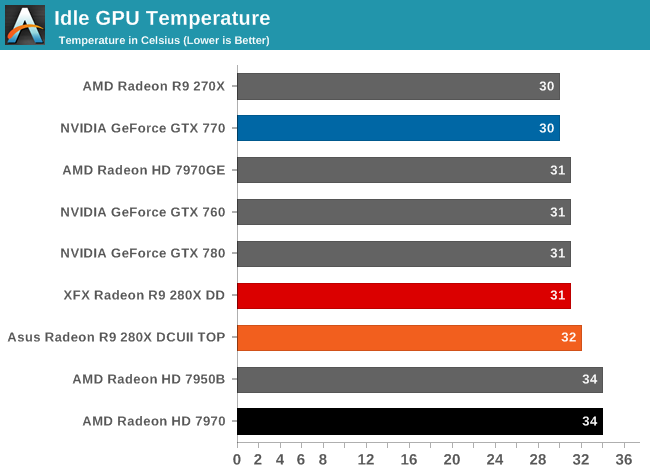
Like most open air coolers, our 280X cards do well enough here. 31C-32C is where most cards will idle at.
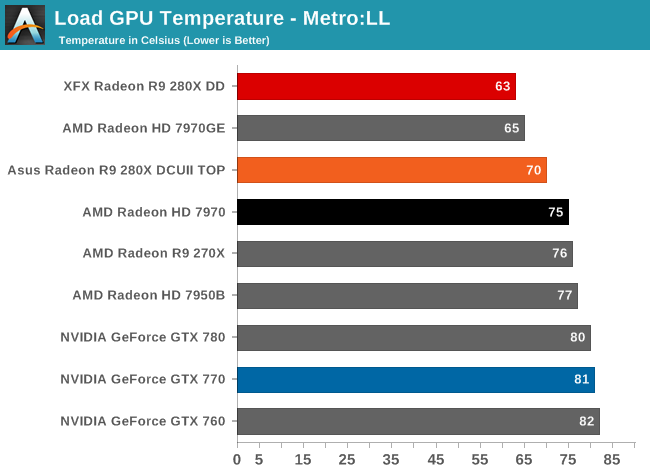
Of all of the Tahiti cards in this article, it’s our XFX 280X that delivers the best temperatures under load. 63 is downright chilly for a 250W card, indicating the card has plenty of thermal headroom. The Asus card by comparison doesn’t fare quite as well, but we don’t even bat an eye until we hit 80C.
It’s worth noting that both cards also do well against the GTX 700 series here, though this is entirely down to the use of open air coolers. As good as these coolers are you won’t be stuffing either card in a cramped case with limited ventilation; for that you need a blower.

As to be expected FurMark drives up our temperatures further. The XFX 280X is no longer our coolest card overall – that goes to the Tahiti based 7970GE – but of the two 280X cards it’s still the cooler one. The Asus meanwhile reaches 76C, which is still a reasonable temperature but it does mean the card doesn’t have a ton of thermal headroom left on its default fan curve. Though if our suspicions are right about the Asus card operating at a higher TDP, then this would at least explain in part the higher temperatures.
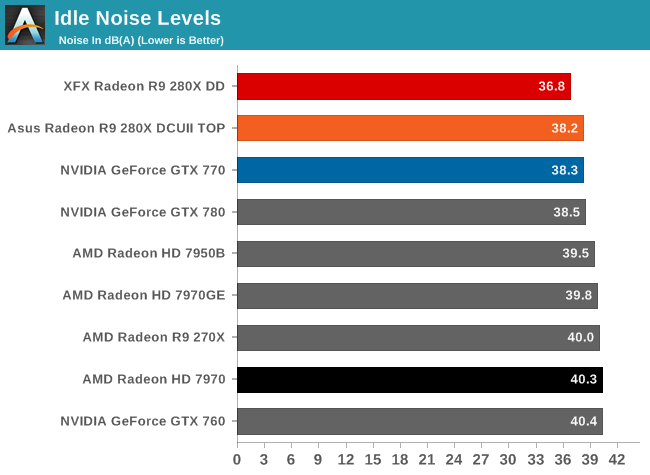
With this being the first article on our new testbed we re-ran the XFX result thrice to make sure we weren’t making any errors, but indeed these results are accurate. Whereas every other card dropped off at around 38dB the XFX 280X bested them with 36.8dB. Even among open air coolers this is a very impressive card at idle. In comparison the Asus is merely average in its near-silence.

Once we start looking at load noise levels however, the picture changes completely. As impressive as the XFX card was at idle, it doesn’t begin to compare to the Asus card under load. We have a card that’s channeling nearly 250W of heat out and away on a sustained basis, and yet for all of that work it generates just 41.5dB(A) of noise on our testbed. This is simply absurd in the most delightful fashion. Most of the cards in our data collection idle at just 2dB lower than this, never mind noise under load. As a result this is incredibly close to being functionally silent; in the case of our testbed the Asus card isn’t even the principle noise source when it’s under load.
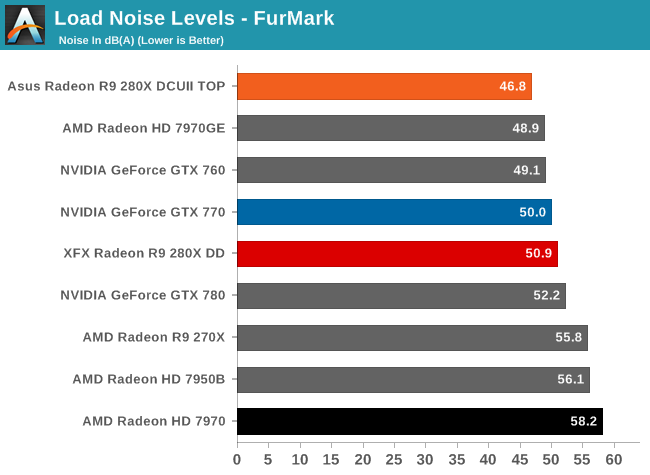
Last, but not least we have noise under FurMark. Although the Asus eventually has to ramp up and leave it’s low-40s comfort zone, at 46.8dB it’s still the quietest card around by 2dB(A). The XFX 280X meanwhile is merely average, if not a tinge worse for an open air cooler. 50.9dB(A) is plenty reasonable, it just pales in comparison to the Asus card.










151 Comments
View All Comments
Galidou - Saturday, October 12, 2013 - link
If he really has to whine about high end video card prices, he's new to this because many generations before, the top of the line was often sold for 800$. Anyway, if you simply run 1080p(which most of us does) you can be totally satisfied with a 150-300$ video card and two or three graphical options not maxed(you won't notice it unless you stop playing to just look at the graphics) which is quite different from older generations where you had to pay big bucks to run at higher resolution/graphical settings.I bought a 660ti for 300$ when it came out a year ago and I still run everything at very high/max settings in 1080p PERFECTLY. No reason to whine at all nowadays unless you're a kiddo that is new to the gaming industry and pc gaming gear.
Etern205 - Monday, October 14, 2013 - link
Many generations before top of the end graphic cards like ATi Radeon 9700 Pro, the best card of its time cost $300, and the 2nd best, ATi Radeon 9500 Pro cost just $200.High-end card is the past don't cost a arm and a leg, you can get one and still have enough to feed yourself for a week. Now they cost a arm and a leg, where you have to starve yourself for a month just to have enough to buy one.
hansmuff - Tuesday, July 14, 2015 - link
The Matrox MGA Millennium 4MB was $549 at launch and became a somewhat legendary performer in DOS VESA modes. That's 1995.bwat47 - Monday, December 9, 2013 - link
Yeah, a 280x was a steal for 299, excellent card.Anand Lal Shimpi - Tuesday, October 8, 2013 - link
We're working on it :) AMD gave Ryan very little time to go through four new cards, it's being added in real time here.Sunrise089 - Tuesday, October 8, 2013 - link
No disrespect Anand, but 'special relationship' with AMD notwithstanding, if they're asking you to have your article up at midnight for a launch but you can't even have product specs available by then I worry the advertising side of things is encroaching a bit into the editorial side.zanon - Tuesday, October 8, 2013 - link
Have to agree. I've always appreciated in the past that Anandtech would take the time to do reviews right, even if it very, very often meant that they'd come in days or more after the early rush. We've already got plenty of early rush stuff on the net that is of poor quality, please do not go that route. Just do a pipeline piece with early conclusions as you have before. You've got this going up across all twitter/rss/whatever feeds, everyone sees it and comes in, and it's a really poor showing.If AMD tells you to hit a certain launch window please kindly tell them to get stuffed or get your hardware earlier next time. If you're letting them rush you to their own schedule that feels like a really bad sign.
Anand Lal Shimpi - Tuesday, October 8, 2013 - link
See the above response, but I'd add: you don't have to worry about us going down the path of lowest common denominator. I hardly think that what was posted here at midnight was even close to fitting that description.Anand Lal Shimpi - Tuesday, October 8, 2013 - link
er below response :)chizow - Tuesday, October 8, 2013 - link
Easy guys, it's happened with other non-AMD reviews too in the past, I know other staff writers will often chip in and help with some aspects of the reviews, like tables and graphs, and sometimes the entire piece comes together online in real-time. It's like a big group project or presentation, sometimes it just doesn't go off perfectly on such short deadlines.